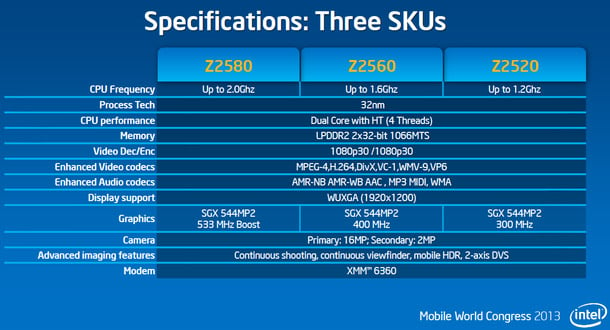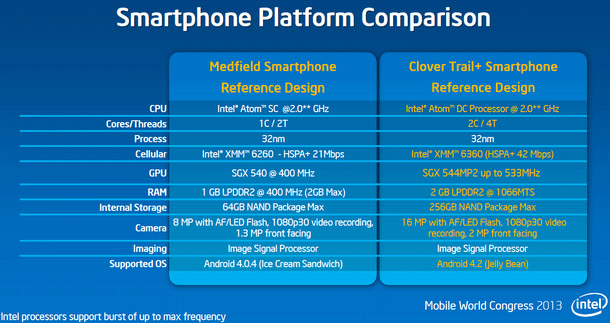Intel Clover Trail+, Advancing Atom In Mobile
Clover Trail+ and Its Variants
From its now dual-core, 4-thread capable Atom core, to its new PowerVR SGX 544MP2 graphics engine, 2GB of LPDDR2 1066 DRAM, up to 256GB of NAND storage, a higher resolution 16MP camera and Intel’s XMM 6360 HSPA+ 42Mbps modem; Intel’s Clover Trail+ smartphone reference design brings a lot more to the table than Medfield ever did.
In fact, you could say that Clover Trail+ stands a very good chance of putting Intel on the map in the US smartphone market. Intel's graphics block and memory bandwidth improvements alone afford the chip significantly more balanced system resources versus Medfield. There is but one check box item you might deem missing here, however, and that's LTE support. 42Mbps HSPA+ has shown to be actually faster in certain areas versus some LTE networks but LTE technology is becoming much more pervasive. As it turns out, Intel has the XMM 7160 LTE chipset in their portfolio and Clover Trail+ will support this as well. For now HSPA+ is in the roll-out with an upgrade path to LTE, so we're told.

In fact, you could say that Clover Trail+ stands a very good chance of putting Intel on the map in the US smartphone market. Intel's graphics block and memory bandwidth improvements alone afford the chip significantly more balanced system resources versus Medfield. There is but one check box item you might deem missing here, however, and that's LTE support. 42Mbps HSPA+ has shown to be actually faster in certain areas versus some LTE networks but LTE technology is becoming much more pervasive. As it turns out, Intel has the XMM 7160 LTE chipset in their portfolio and Clover Trail+ will support this as well. For now HSPA+ is in the roll-out with an upgrade path to LTE, so we're told.
Clover Trail+ Variants –
There will be three primary derivatives of Clover Trail+ platforms. All three will incorporate the same base feature set, they will just vary in terms of CPU and graphics core clock speeds. This is a reasonable approach for handset manufacturers especially, since it will allow for less complex BOM (Bill of Materials) sets in manufacturing of various types of smartphones with different price points.
The top-end Atom Z2580 SoC will drop in at a 2GHz clock speed, similar to Medfield, only again, offering a dual-core CPU with Intel HyperThreading. On a side note, Intel did confirm that the latest version of Android 4.2 Jelly Bean is logical thread-aware and can take advantage of Intel’s HyperThreading load balancing algorithms. Regardless, when it comes to smartphones, multithreaded applications are still few and far between, though there are clearly applications in gaming, multimedia and encoding that will make better use of threading in the future.
As we see here, Intel will offer a 1.6GHz CPU/400MHz GPU version dubbed the Z2560 and a 1.2GHz CPU/300MHz GPU Atom Z2520 model as well. You’ll also note all variants support 1920X1200 display resolutions and accelerated 1080p video encoding and decoding.
As we see here, Intel will offer a 1.6GHz CPU/400MHz GPU version dubbed the Z2560 and a 1.2GHz CPU/300MHz GPU Atom Z2520 model as well. You’ll also note all variants support 1920X1200 display resolutions and accelerated 1080p video encoding and decoding.
Clover Trail+ Imaging Capabilities –
Intel has put heavy emphasis on the imaging horsepower and feature set of its new smartphone platform. This makes sense since obviously smartphones are doubling more and more as secondary still image and video cameras. A high quality, high resolution camera is no longer just a bonus feature, it's a hard requirement.


Intel is not only claiming zero shutter lag with Clover Trail+ driven smartphones, they’re offering up 8MP burst shooting at 15fps and continuous 8MP snaps at 3fps. In addition, Atom Z25XX-powered cameras will support face detection and recognition technologies.


These are relatively impressive capabilities for a smartphone camera, and along with video stabilization, 1080p recording, HDR image capture, anti-ghosting and motion blur reduction technologies, Clover Trail+ could offer one of the best digital camera implementations in the smartphone market currently.







